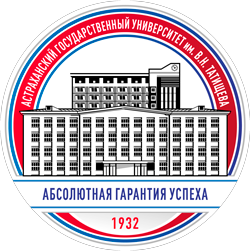ASU is a multidisciplinary educational complex in the region with unique resources and competitive advantages:
– Modern scientific and educational infrastructure of the University[1], formed taking into account the geographical and geopolitical location of the Astrakhan region (the border geostrategic territory of the country[2], representing Russia in the strategically important Caspian macroregion).
– ASU is a leader in training specialists for region-shaping clusters[3].
– Membership in associations of leading universities of the European Union and Asia; cooperation with major leading foreign and Russian organizations in the field of science, education and economics, public authorities[4].
– ASU is the leader of the region and the Southern Federal District in innovative technologies and a project-oriented approach to teaching engineering specialties (CDIO).
– High level of students’ involvement in scientific research (more than 70%).
– Deep orientation of ASU scientific school to the final results.
– Formed team of highly qualified specialists of the scientific pedagogical school[5].
Merging ASU with the Astrakhan State University of Architecture and Civil Engineering (ASUACE) will strengthen the competitive advantages of ASU that will expand the number of training programs for engineering and transport infrastructure; will ensure consolidation of regional and federal financial resources; will complete the formation of the distributed (network) university and will create the architecture of a “region-shaping” university, expand the university’s participation in the development of main regional clusters and strengthen the ASU position as a territorial leader.
The university maintains the effective functioning of the integral system and considers a set of positioning models for development: 1) affordable high-quality education for the population with different income levels; 2) a modern university ecosystem with a campus, convenient location, unique educational programs, which are less expensive in comparison with programs in elite universities; 3) categorization of scientific and pedagogical specialist, reduction of bureaucratic procedures of accompanying processes.
The available resources will allow ASU to become an integrator in the scientific and educational area of the Caspian macroregion, to develop export of educational services for the Caspian countries, CIS and SCO countries[6]. The multilevel system of educational programs (vocational secondary education, higher and supplementary vocational education) will ensure the content and competence continuity of educational levels, creating conditions for comprehensive and continuous professional development. After merging the ASU with ASUACE, the diversification of the nomenclature of specialities will be continued, taking into account the demand of region-shaping clusters[7]. Expansion of the pool of strategic partners and development of integration contacts will allow to ensure the personnel and technological needs of region’s economy[8].
The implementation of strategic projects will contribute to the ASU transformation into entrepreneurial research university. The new role of the University development is unique innovative educational products aimed at mastering new professions and obtaining innovative skills, ensuring territorial leadership in the research and technological aspect, aimed at the development of the region’s economy. The program will make a significant contribution to the achievement of the national development goals of the Russian Federation until 2030[9] and will allow solving tasks of the federal and regional levels[10].
[1] The existing scientific and educational infrastructure of ASU: the Research and Educational Center for Advanced Studies of the Caspian Macroregion (REC “Kaspy”, whose goal is to obtain new competitive technologies and products, commercialize them, transfer to the Caspian countries, as well as train specialists to solve scientific and technological tasks concerning the problems of the Caspian Sea); the Caspian Scientific Youth Project Office; the center for technology transfer and engineering center at the Engineering Project Office; the center for humanitarian cooperation of the Caspian countries; the center for Russian-Indian Advanced Studies; the Caspian International Discussion Club; the Caspian Interpreting Translation School, the Center for Korean Language and Culture; the Center for Russian-American Cooperation, the Center for Education, Science and Technology of ASU in Baku, the UNESCO Chair.
[2] The Strategy of Spatial Development of the Russian Federation up to 2025, approved by the decree of the Government of the Russian Federation No. 207-r of February 13, 2019
[3] fuel and chemical, agro-industrial complex and aquaculture, tourist and recreational, Caspian innovation and educational, transport and logistics (container hub, logistics center of the International North–South Transport Corridor)
[4] over the past five years over 350 cooperation agreements were concluded
[5] successful implementation of federal projects of the National Project “Education” (“Teacher of the future”, “Every Child’s Success”, “New opportunities for everyone”), based on the Just-in-Time principle.
[6] the project “Creation of the Center for Humanitarian Cooperation of the Caspian Region Countries”: developing and strengthening international and interregional cooperation of the Caspian Region Countries in humanitarian area.
[7] Formation of the individual educational trajectory in training specialists for the urban planning sector and related fields at ASU will increase the competitiveness of the university and its specialists
[8] A network of basic chairs will be created at the regional enterprises, various formats of targeted training will be introduced by employers’ order. Employers’ participation in financing university projects, including scholarships, research grants, supplying sites with modern equipment.
[9] maintenance of the population, health and well-being; opportunities for self-actualization and development of talents; a comfortable and safe living environment; decent, efficient work and successful entrepreneurship; digital transformation.
[10]improving the mechanisms of maintaining the stability of the country, creating conditions for sustainable social and economic development. Training personnel for the development of the border geostrategic territory. Concentrating of the scientific and educational potential of the Caspian macroregion. Improving the living standards: creating comfortable living environment for settlements, developing their transport and infrastructure, satisfying the demand for accommodation in dormitories. Processability and innovativeness of the economy: intensive renovation of the basic economy sectors (industry, construction, transport, energy, agriculture, mineral production), use of modern production and processing technologies, rationally use of natural resources.
